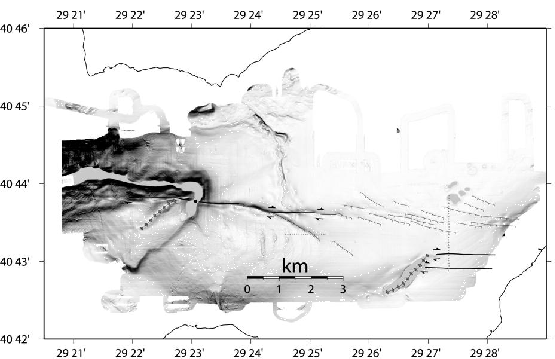 |
The present project is based on many previous research cruises carried out using R/V Odin Finder and R/V Urania and also on cruises of R/V Le Soroit and R/V L'Atalante within the framework of an Italy,France,USA and Turkey collaborative programme. The key areas have been identified through the interpretation of the previously collected geophysical and geological data along the NAF strands and cruise work was designed in order to map active structures and features likely useful to understand fault kinematics. For details about some of these cruises see:
figure
The references in bibliography cover broad aspects of the scientific problems and issues relating to the NAF in the Sea of Marmara, among the many others, tectonics, seismology, geochemical and sedimentary processes SENGOR1979,BARKA92,CAGATAY1998, HUBERT-FERRARI2002, SENGOR2004, SENGOR1985, ARMIJO1999, MCCLUSKY2002, ARMIJO2002,LEPICHON2001,LEPICHON2003,AKSU2000,IMREN2001,GOKASAN2001,KUSKU2009, ALPAR2002,DEMIRBAG2003,BARKA88,BARKA92, STEIN1997, OKAY2000,PARKE2002,FLERIT2003,POLONIA2004,MEADE2002, AMBRASEYS91, PROVOST2003,SHINDLER1997,OKAY2004, POLONIA2002-EOS.
Moreover, in recent years a lot of effort was also devoted to the study of cold seeps, gas and fluid emissions. GELI08 presents the results of geophysical investigations and of submersible dives during cruises MARMARA (R/V Le Suroit, September 2000) and MARNAUT (R/V L'Atalante, May-June 2007), pointing to clearcut evidence of gas and fluid emissions and active tectonics in the Dea of Marmara, particularly in the ÇinarcikBasin. CAGATAY2009 discusses the late Pleistocene-Holocene stratigraphy of the northern shelf of the Sea of Marmara extending back to isotope stage 6. This study reports the discovery of two new sapropel units deposited during isotope stage 5 highstand and discusses water exchange between the Black Sea and Mediterranean through the Sea of Marmara during various isotopic stages, based on seismic stratigraphic and core analyses.